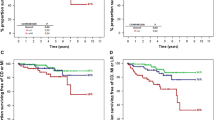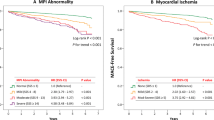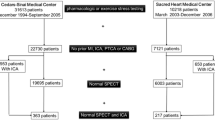Abstract
Background
Annual mortality rate can range from <1% for patients with normal myocardial perfusion by SPECT to >5% based on a high-risk Duke treadmill score (DTS). Information on the prognosis of patients with the combination of HRDTS and normal SPECT is limited and is the purpose of this study.
Methods
Data from a large nuclear cardiology registry (n = 17,972 patients) were reviewed. A total of 340 had HRDTS (score ≤ −11) while undergoing SPECT. Combined cardiovascular mortality and non-fatal myocardial infarction (MI) and cardiovascular mortality alone were available in 310 patients at a mean follow-up of 4.01 ± 1.5 years.
Results
The majority of the patients had abnormal SPECT (n = 270, 71%). The abnormal SPECT patients compared to the normal were older (65.6 vs 62.8 years of age; P = .025), more likely to have abnormal left ventricular ejection fraction (26.1% vs 0%; P < .0001), known coronary artery disease (CAD, 35.9% vs 7.8%; P < .0001) and lower DTS (−14.5 vs −13.2; P = .0006), Kaplan-Meier survival analysis demonstrated a significantly lower cardiovascular mortality (5.4% vs 0%, P = .02) and combined outcome of MI and cardiovascular mortality (15% vs 4.4%, P = .009) in patients with normal versus abnormal SPECT.
Conclusions
High-risk DTS is associated with abnormal perfusion SPECT in most patients, but nearly one-third of the patients had normal perfusion. Patients with a normal SPECT had a lower cardiovascular event rates.




Similar content being viewed by others
Abbreviations
- SPECT:
-
Single photon-emission computed tomography
- MPI:
-
Myocardial perfusion imaging
- DTS:
-
Duke treadmill score
- CAD:
-
Coronary artery disease
- CV:
-
Cardiovascular
- LV:
-
Left ventricular
- MI:
-
Myocardial infarction
- STD:
-
ST segment deviation
- METS:
-
Metabolic equivalents
- SSS:
-
Summed stress score
References
Bokhari S, Shahzad A, Bergmann SR. Superiority of exercise myocardial perfusion imaging compared with the exercise ECG in the diagnosis of coronary artery disease. Coron Artery Dis 2008;19:399–404.
Mark DB, Hlatky MA, Harrell FE Jr, Lee KL, Califf RM, Pryor DB. Exercise treadmill score for predicting prognosis in coronary artery disease. Ann Intern Med 1987;106:793–800.
Mark DB, Shaw L, Harrell FE Jr, Hlatky MA, Lee KL, Bengtson JR, et al. Prognostic value of a treadmill exercise score in outpatients with suspected coronary artery disease. N Engl J Med 1991;325:849–53.
Fihn SD, Gardin JM, Abrams J, Berra K, Blankenship JC, Dallas AP, et al. 2012 ACCF/AHA/ACP/AATS/PCNA/SCAI/STS Guideline for the diagnosis and management of patients with stable ischemic heart disease: a report of the American College of Cardiology Foundation/American Heart Association Task Force on Practice Guidelines, and the American College of Physicians, American Association for Thoracic Surgery, Preventive Cardiovascular Nurses Association, Society for Cardiovascular Angiography and Interventions, and Society of Thoracic Surgeons. J Am Coll Cardiol 2012;60:e44–164.
Muzzarelli S, Pfisterer ME, Muller-Brand J, Zellweger MJ. Gate-keeper to coronary angiography: Comparison of exercise testing, myocardial perfusion SPECT and individually tailored approach for risk stratification. Int J Cardiovasc Imaging 2010;26:871–9.
Schinkel AF, Boiten HJ, van der Sijde JN, Ruitinga PR, Sijbrands EJ, Valkema R, et al. 15-Year outcome after normal exercise (9)(9)mTc-sestamibi myocardial perfusion imaging: What is the duration of low risk after a normal scan? J Nucl Cardiol 2012;19:901–6.
Cerci MS, Cerci JJ, Cerci RJ, Pereira Neto CC, Trindade E, Delbeke D, et al. Myocardial perfusion imaging is a strong predictor of death in women. JACC Cardiovasc Imaging 2011;4:880–8.
Fletcher GF, Balady GJ, Amsterdam EA, Chaitman B, Eckel R, Fleg J, et al. Exercise standards for testing and training: A statement for healthcare professionals from the American Heart Association. Circulation 2001;104:1694–740.
Sociedade Brasileira de Cardiologia. III Guidelines of Sociedade Brasileira de Cardiologia on the exercise test. Arq Bras Cardiol 2010;95:1–26.
Bruce RA. Exercise testing of patients with coronary heart disease. Principles and normal standards for evaluation. Ann Clin Res 1971;3:323–32.
Pollock ML, Wilmore J, editors. Exercise in health and disease: Evaluation and prescription for prevention and rehabilitation. 2nd ed. Philadelphia: Saunders; 1990.
Holly TA, Abbott BG, Al-Mallah M, Calnon DA, Cohen MC, DiFilippo FP, et al. Single photon-emission computed tomography. J Nucl Cardiol 2010;17:941–73.
Cerqueira MD, Weissman NJ, Dilsizian V, Jacobs AK, Kaul S, Laskey WK, et al. Standardized myocardial segmentation and nomenclature for tomographic imaging of the heart. A statement for healthcare professionals from the Cardiac Imaging Committee of the Council on Clinical Cardiology of the American Heart Association. J Nucl Cardiol 2002;9:240–5.
Hachamovitch R, Berman DS, Shaw LJ, Kiat H, Cohen I, Cabico JA, et al. Incremental prognostic value of myocardial perfusion single photon emission computed tomography for the prediction of cardiac death: Differential stratification for risk of cardiac death and myocardial infarction. Circulation 1998;97:535–43.
Sterne JA, White IR, Carlin JB, Spratt M, Royston P, Kenward MG, et al. Multiple imputation for missing data in epidemiological and clinical research: potential and pitfalls. BMJ 2009;338:b2393.
Shaw LJ, Peterson ED, Shaw LK, Kesler KL, DeLong ER, Harrell FE Jr, et al. Use of a prognostic treadmill score in identifying diagnostic coronary disease subgroups. Circulation 1998;98:1622–30.
Diercks DB, Gibler WB, Liu T, Sayre MR, Storrow AB. Identification of patients at risk by graded exercise testing in an emergency department chest pain center. Am J Cardiol 2000;86:289–92.
Iskandrian AS, Ghods M, Helfeld H, Iskandrian B, Cave V, Heo J. The treadmill exercise score revisited: Coronary arteriographic and thallium perfusion correlates. Am Heart J 1992;124:1581–6.
Furberg CD, Adams HP Jr, Applegate WB, Byington RP, Espeland MA, Hartwell T, et al. Effect of lovastatin on early carotid atherosclerosis and cardiovascular events. Asymptomatic Carotid Artery Progression Study (ACAPS) Research Group. Circulation 1994;90:1679–87.
Downs JR, Clearfield M, Weis S, Whitney E, Shapiro DR, Beere PA, et al. Primary prevention of acute coronary events with lovastatin in men and women with average cholesterol levels: Results of AFCAPS/TexCAPS. Air Force/Texas Coronary Atherosclerosis Prevention Study. JAMA 1998;279:1615–22.
Randomised trial of cholesterol lowering in. 4444 patients with coronary heart disease: The Scandinavian Simvastatin Survival Study (4S). Lancet 1994;344:1383–9.
Blankenhorn DH, Azen SP, Kramsch DM, Mack WJ, Cashin-Hemphill L, Hodis HN, et al. Coronary angiographic changes with lovastatin therapy. The Monitored Atherosclerosis Regression Study (MARS). Ann Intern Med 1993;119:969–76.
Hjalmarson A, Elmfeldt D, Herlitz J, Holmberg S, Malek I, Nyberg G, et al. Effect on mortality of Metoprolol in acute myocardial infarction. A double-blind randomised trial. Lancet 1981;2:823–7.
Kjekshus J, Gilpin E, Cali G, Blackey AR, Henning H, Ross J Jr. Diabetic patients and beta-blockers after acute myocardial infarction. Eur Heart J 1990;11:43–50.
Boden WE, O’Rourke RA, Teo KK, Hartigan PM, Maron DJ, Kostuk WJ, et al. Optimal medical therapy with or without PCI for stable coronary disease. N Engl J Med 2007;356:1503–16.
Frye RL, August P, Brooks MM, Hardison RM, Kelsey SF, MacGregor JM, et al. A randomized trial of therapies for type 2 diabetes and coronary artery disease. N Engl J Med 2009;360:2503–15.
Henderson RA, Pocock SJ, Clayton TC, Knight R, Fox KA, Julian DG, et al. Seven-year outcome in the RITA-2 trial: Coronary angioplasty versus medical therapy. J Am Coll Cardiol 2003;42:1161–70.
Hueb WA, Bellotti G, de Oliveira SA, Arie S, de Albuquerque CP, Jatene AD, et al. The Medicine, Angioplasty or Surgery Study (MASS): A prospective, randomized trial of medical therapy, balloon angioplasty or bypass surgery for single proximal left anterior descending artery stenoses. J Am Coll Cardiol 1995;26:1600–5.
Poornima IG, Miller TD, Christian TF, Hodge DO, Bailey KR, Gibbons RJ. Utility of myocardial perfusion imaging in patients with low-risk treadmill scores. J Am Coll Cardiol 2004;43:194–9.
Hubbard BL, Gibbons RJ, Lapeyre AC 3rd, Zinsmeister AR, Clements IP. Identification of severe coronary artery disease using simple clinical parameters. Arch Intern Med 1992;152:309–12.
Metz LD, Beattie M, Hom R, Redberg RF, Grady D, Fleischmann KE. The prognostic value of normal exercise myocardial perfusion imaging and exercise echocardiography: A meta-analysis. J Am Coll Cardiol 2007;49:227–37.
Gibbons RJ, Hodge DO, Berman DS, Akinboboye OO, Heo J, Hachamovitch R, et al. Long-term outcome of patients with intermediate-risk exercise electrocardiograms who do not have myocardial perfusion defects on radionuclide imaging. Circulation 1999;100:2140–5.
Boiten HJ, van der Sijde JN, Ruitinga PR, Valkema R, Geleijnse ML, Sijbrands EJ, et al. Long-term prognostic value of exercise technetium-99m tetrofosmin myocardial perfusion single-photon emission computed tomography. J Nucl Cardiol 2012;19:907–13.
Duvall WL, Hiensch RJ, Levine EJ, Croft LB, Henzlova MJ. The prognosis of a normal Tl-201 stress-only SPECT MPI study. J Nucl Cardiol 2012;19:914–21.
Yusuf S, Zucker D, Peduzzi P, Fisher LD, Takaro T, Kennedy JW, et al. Effect of coronary artery bypass graft surgery on survival: Overview of 10-year results from randomised trials by the Coronary Artery Bypass Graft Surgery Trialists Collaboration. Lancet 1994;344:563–70.
Shaw LJ, Hendel R, Borges-Neto S, Lauer MS, Alazraki N, Burnette J, et al. Prognostic value of normal exercise and adenosine (99m)Tc-tetrofosmin SPECT imaging: Results from the multicenter registry of 4,728 patients. J Nucl Med 2003;44:134–9.
Schalet BD, Kegel JG, Heo J, Segal BL, Iskandrian AS. Prognostic implications of normal exercise SPECT thallium images in patients with strongly positive exercise electrocardiograms. Am J Cardiol 1993;72:1201–3.
He ZX, Dakik HA, Vaduganathan P, Qureshi U, Mahmarian JJ, Verani MS. Clinical and angiographic significance of a normal thallium-201 tomographic study in patients with a strongly positive exercise electrocardiogram. Am J Cardiol 1996;78:638–41.
Hilton TC, Shaw LJ, Chaitman BR, Stocke KS, Goodgold HM, Miller DD. Prognostic significance of exercise thallium-201 testing in patients aged greater than or equal to 70 years with known or suspected coronary artery disease. Am J Cardiol 1992;69:45–50.
Galassi AR, Azzarelli S, Tomaselli A, Giosofatto R, Ragusa A, Musumeci S, et al. Incremental prognostic value of technetium-99m-tetrofosmin exercise myocardial perfusion imaging for predicting outcomes in patients with suspected or known coronary artery disease. Am J Cardiol 2001;88:101–6.
Pattillo RW, Fuchs S, Johnson J, Cave V, Heo J, DePace NL, et al. Predictors of prognosis by quantitative assessment of coronary angiography, single photon emission computed tomography thallium imaging, and treadmill exercise testing. Am Heart J 1996;131:582–90.
Disclosure
The authors have indicated that they have no financial conflict of interest.
Author information
Authors and Affiliations
Corresponding author
Additional information
See related editorial, doi:10.1007/s12350-015-0187-3.
Rights and permissions
About this article
Cite this article
Vítola, J.V., Wanderley, M.R.B., Cerci, R.J. et al. Outcome of patients with high-risk Duke treadmill score and normal myocardial perfusion imaging on spect. J. Nucl. Cardiol. 23, 1291–1300 (2016). https://doi.org/10.1007/s12350-015-0156-x
Received:
Accepted:
Published:
Issue Date:
DOI: https://doi.org/10.1007/s12350-015-0156-x




